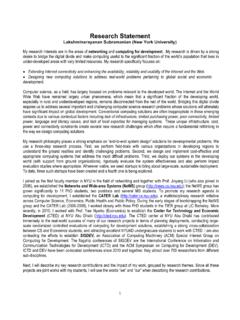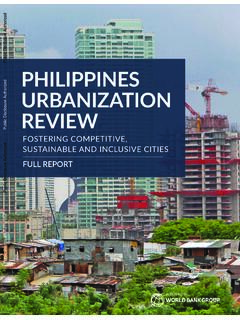Transcription of ENTREPRENEURIAL ECOSYSTEMS AND GROWTH ORIENTED ...
1 ENTREPRENEURIAL ECOSYSTEMS AND GROWTH ORIENTED ENTREPRENEURSHIP By Prof. Colin Mason1 and Dr. Ross Brown2 Background paper prepared for the workshop organised by the OECD LEED Programme and the Dutch Ministry of Economic Affairs on ENTREPRENEURIAL ECOSYSTEMS and GROWTH ORIENTED Entrepreneurship The Hague, Netherlands, 7th November 2013. Final Version: January 2014 Increasing the number of high GROWTH firms (HGFs) is now a major focus for industry policy in developed countries. However, existing approaches are proving ineffective.
2 Simply creating supportive framework conditions is insufficient. Creating favourable environments for business start-ups is not leading to the creation of more HGFs. And transactional forms of support for HGFs ( financial assistance) are proving to have limited effectiveness, at least post-start-up. The entrepreneurship ecosystem approach has emerged as a response. It recognises that HGFs flourish in distinctive types of supportive environment. Distinguishing features of ENTREPRENEURIAL ECOSYSTEMS include the following: a core of large established businesses, including some that have been entrepreneur-led ( ENTREPRENEURIAL blockbusters); ENTREPRENEURIAL recycling whereby successful cashed out entrepreneurs reinvest their time, money and expertise in supporting new ENTREPRENEURIAL activity; and an information-rich environment in which this information is both accessible and shared.
3 A key player in this context is the deal-maker who is involved in a fiduciary capacity in several ENTREPRENEURIAL ventures. Other important aspects of an ENTREPRENEURIAL ecosystem include its culture, the availability of start-up and GROWTH capital, the presence of large firms, universities and service providers. However, studies have tended to take a static approach to the study of ENTREPRENEURIAL ECOSYSTEMS , largely ignoring both their origins and stimulus and also the processes by which they become self-sustaining.
4 Creating ENTREPRENEURIAL ECOSYSTEMS poses various challenges for policy-makers. There are several general principles that need to be followed. Policy intervention needs to take a holistic approach, focusing on the following: the ENTREPRENEURIAL actors within the ecosystem; the resource providers within the ecosystem; ENTREPRENEURIAL connectors within the ecosystem and the ENTREPRENEURIAL environment of the ecosystem. Finally, it is important that policy-makers develop metrics in order to determine the strengths and weaknesses of individual ECOSYSTEMS so that their strengths and weaknesses can be assessed, to identify whether and how to intervene, and monitor over time the effectiveness of such interventions.
5 What to measure, approaches to measurement and access to data at the appropriate geographical scales all pose formidable challenges. 1 . Adam Smith Business School, University of Glasgow, Glasgow, UK. 2 . School of Management, University of St Andrews, St Andrews, UK. 2 TABLE OF CONTENTS Introduction: developments in industrial policy .. 3 Unpacking ENTREPRENEURIAL ECOSYSTEMS .. 6 Related concepts .. 6 Distinguishing Features of ENTREPRENEURIAL ECOSYSTEMS .. 8 The Dynamic Nature Model of ENTREPRENEURIAL ECOSYSTEMS .
6 12 Supporting ENTREPRENEURIAL ECOSYSTEMS : the role of policy .. 19 General Principles .. 19 Approaches to Policy .. 20 Metrics for ENTREPRENEURIAL ECOSYSTEMS .. 24 Conclusions .. 26 Acknowledgements .. 28 Biography of the authors .. 28 Professor Colin Mason .. 28 Dr. Ross Brown .. 28 References .. 29 3 Introduction: developments in industrial policy Over the last sixty years there has been an evolution in the manner in which governments in advanced countries have undertaken industrial and enterprise policies (Warwick, 2013).
7 3 Over the past twenty years there has been an escalation in both the quantity of policy initiatives and the level of funding committed to these activities in a process termed the developmental state (Rodrik, 2004; Block, 2008). These changes can be summarised as a shift from traditional enterprise policies to GROWTH - ORIENTED enterprise policies and has involved significant changes in the unit of focus, how it operates and how it interconnects with other policies. This has resulted in a gradual change, varying across different countries, towards a much greater focus on support for GROWTH - ORIENTED entrepreneurship as outlined in Table 1, The consequence is that policy makers across the OECD are now strongly focused on promoting high GROWTH firms (HGFs) (OECD, 2010; 2013).
8 The rationale for this focus is that HGFs are thought to drive productivity GROWTH , create new employment, increase innovation and promote business internationalization (OECD, 2013; Brown et al, 2014). A recent meta-analysis of prior empirical studies concluded that a few rapidly growing firms generate a disproportionately large share of all net new jobs compared with non-high GROWTH firms. This is a clear-cut [T]his is particularly pronounced in recessions when Gazelles continue to grow (Henrekson and Johansson, 2010; 240).
9 The policy interest in HGFs can therefore be explained largely in one word: jobs (Coad et al, 2014). An influential UK study covering the period 2002-2008 found that HGFs represented about 6% of the total number of businesses (termed the vital six percent ) but created 54% of all net new jobs in the UK (Anyadike-Danes et al, 2009). The majority of these HGFs were small (less than 50 employees) but well established (over five years old). Moreover, these firms are distributed across all industry sectors, with no bias towards technology-based firms.
10 Updating this research to cover the onset of the financial crisis (2008-10) found that the number of HGFs was very similar to both the 2002-2005 and 2005-2008 periods and that, as before, they generated more than half of all new jobs created by firms with 10 or more employees, emphasising that HGFs are equally significant in periods of economic GROWTH and recession (NESTA, 2011). HGFs do not only create jobs directly; they also have important spill-over effects that are beneficial to the GROWTH of other firms in the same locality (Mason et al, 2009; Du et al, 2013) and industrial cluster (Feldman et al, 2005; Brown, 2011).


















